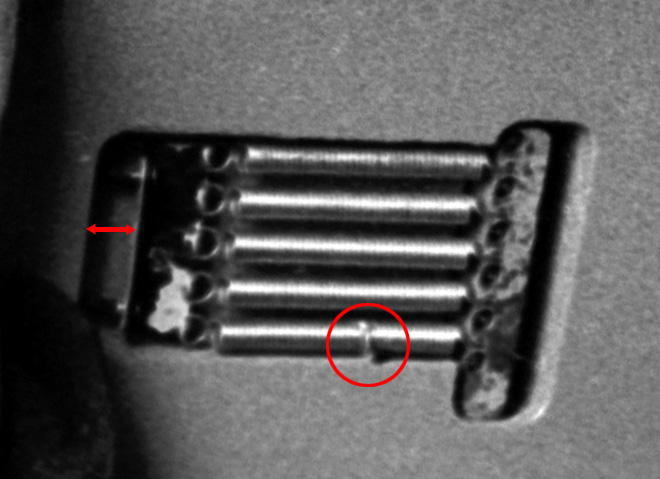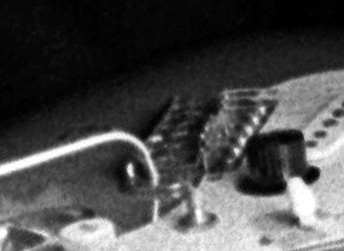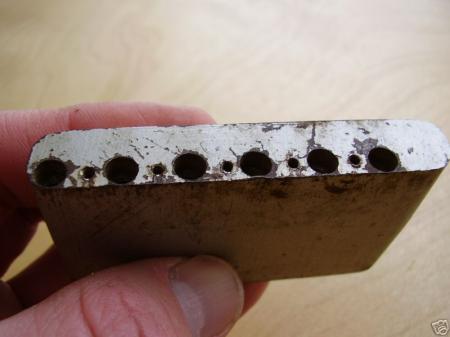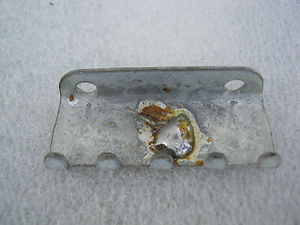When browsing Adrian Boot’s Dire Straits photos, I found one from early 1980 that allowed a very rare view on Mark’s 1961 “Sultans” Stratocaster: a view on the back of the guitar. As the tremolo cover plate is missing on this guitar – back then and still today – we can see the inside of the tremolo cavity. From some other pictures or video stills, I already got the vague impression that Mark had five tremolo springs, but here it is finally proven. Besides we can see how the tremolo claw (the part that holds the springs) is adjusted. As you know, the two screws that hold the claw in the body allow to adjust the tension of the springs. The ditance between the claw and the end of the tremolo cavity (red arrow) seems to be an estimated 12 – 13 mm (1/2 “). With this setting, the springs are hardly stretched.

If I set up my guitar this way, even with 010 strings the five springs have enough pull to keep the tremolo base plate fixed to the body, in other words, no floating tremolo. This matches the picture below that shows the tremolo on Mark’s guitar. (Too bad, if it was floating, we maybe even could have been able to estimate the string gauge from the tremolo angle, note that we have no reliable information on the string gauge in the 1977 – 79 period at all, anything from 08 – 010 is possible!!)

I am not sure what we see in the red circle. As this is near the place where the grounding cable from the electronics cavity enters the tremolo cavity, my guess is that the cable is attached to the spring instead of to the claw. As Mark used to swap the complete loaded pickguard from one of his red Fenders to the others then (see also here), it was possibly easier and quicker to do it this way. It should be possible to pinch the wire between the spring coil, but it looks rather to be soldered (?).
We know that the guitar was refinished to red (around summer or autumn 1978, it was bare wood finish before). Here is another proof: all screw holes of the tremolo cover plate are filled from the paint job.
The tremolo block looks original (the scratchy look is typical for old Fender blocks, compare picture below). At least we can tell from this that the Sultans Strat does not have a brass replacement block (seems trivial but thanks to companies like Schecter or Mighty Mite brass replacements were a very common upgrade in the late 70ies). I am not convinced about the originality of the claw which looks a bit too rectangular while the original ones are rather trapezoid (compare to picture below) but this might simply be an illusion (this part normally does not get lost, and why should someone exchange it?).


And one more conclusion from the picture: Mark possibly played Fender strings then (confirmed for the 1980/81 period), but these do not seem to be the Fender bullet strings that were common then as well (which do not have the typical ball end but a more solid “bullet” end instead). I guess we should be able to see those bullets on the picture if he had these.

12 thoughts on “Tremolo Setup of the Sultans Strat”
ah great !
it seems my comment gave you inspiration for a new article 😉
so the fact that the tremolo cover plate is missing should be due to the screw holes filled after the paint job.
I used a wrong word (my english si so average) when I said “floating”.
I meant that the angle was not the same as usual. I was not talking about the plate, but about the arm : on the pic above it looks like “hanging”, wile e.g on this chorus pic he looks like “more screwed” :
http://www.mk-guitar.com/mark-knopfler-gear-database/fender-stratocaster-1961/
>>so the fact that the tremolo cover plate is missing should be due to the screw holes filled after the paint job.
I’d see it the other way: as there is/was no cover plate, noone cared to open the holes after the refin job again, or they were even professionally filled before the paint job as there was no cover anyway.
Good one!
Changing the subject, Any progress with the “Walk of Life Telecaster”?
cheers,
Arthur
You mention that their is no reliable information of Mark’s string gage from ’79 to ’80. I recall that he mentioned using .008’s from an interview with him in Musician Magazine in 1980. The one with him and the red strat on the cover. I’m sure you’re aware of this, maybe even discussed on this website somewhere?
Mike
Right, you mean this one: http://www.mk-guitar.com/2008/09/14/how-to-get-that-sultans-of-swing-sound-mark-knopfler-played-08-strings/
However, this magazine is from the transition period when Mark already started to play Schecters, so we have no idea if the info about 08 strings (if accurate) refers to the Fenders he played up to then, or to the Schecters which he just had started to play.
I always found that his tone on MM tour sounded “thinner” than before.
it doesn’t have this warm tone we can hear in 78-79.
Dormtund : TOL, waterline…it sounds “thin” IMHO
Of course it could be anything else (PU, amps, effects, etc…) but it also could mean that he used 08 strings in 80-81, and it would fit with the itw.
Hi there!
I agree with the “thin” sound during the MM Tour.
My guess is the guitar signal was (guitar-effects-amp(no cab)-board-PA), maybe even a pre-amp.
The guitar sound is typically a guitar plugged directly on board.
For me that is the reason of the “thin” MM tour sound.
You might be right.
As said, the magazine with the 08 info (to be concrete: Fender Super lights which was Fender’s 08 set: 08, 11, 14, 22, 30, 38)) comes from a transition time (after recording Making Movies, before the On Location tour). The Making Movies tourbook (probably from early 1981 rather than 1980) said Fender Extra Lights (= 09, 11, 15, 24, 32, 40).
I meanwhile play 10s again for the earlier DS sound (I like both the advantages of 10s and 08s and am normally indecisive which to favour). It is possible that Mark used 10s with the Fenders. He said that his fingers were always cut from the strings during a tour and that he needs to look for a guitar that is easier to play. So it makes sense to assume that he changed to a lighter gauge with the Schecters in 1980 (which had more powerful pickups) and possibly recorded Making Movies with 08s. When starting the tour he went back to a slightly higher gauge (09) as maybe 08 were too thin for the big stages they entered by then. On the next tour he went for 09s with thicker bass strings BTW (Deam Markley Custom Lights: 09, 11, 16, 26, 36, 46)
Today he played 09s and 010s but also changes from time to time (e.g. in Leipzig 2010 he changed from 09s to 10s for Sultans for example) so it seems Mark has similar deciding problems as we have 🙂
@Arthur
At least the recording from Werchter 1981 has this strange direct-into-desk sound, agreed.
just a precision about the article I read again.
It’s common said that SRV used heavy strings. It’s right, but it has to be nuanced by the fact that (like Hendrix) SRV tuned his guitar a 1/2 tone below(Eb), so the action was a little bit lower than normal.
therefore,heavy strings (10 or 11 ?) with a lower action could be like thinner strings (9-10) with a normal action, I believe
I distinctly remember reading that Knopfler used extra-light (9-42) strings, and from the tone he got and watching him play that seems evident, obvious even. I didn’t look it up before posting my comment, but pretty sure it should be easy to find by doing some research. While old strats often look very “relic”, his strats seem to be in good condition considering how much, and how hard he played them. That just goes to show that if someone takes good care of their guitar it will age “nicer” (if that’s the right word?).
There is no info at all available on his string gauge from the time of the first two albums. For the 80ies and 90ies we have various sources that say 09-40 (On Location tour), 09-46 (Alchemy tour), and 09-42 (OES tour)
Great post! Long time guitarist new to strats